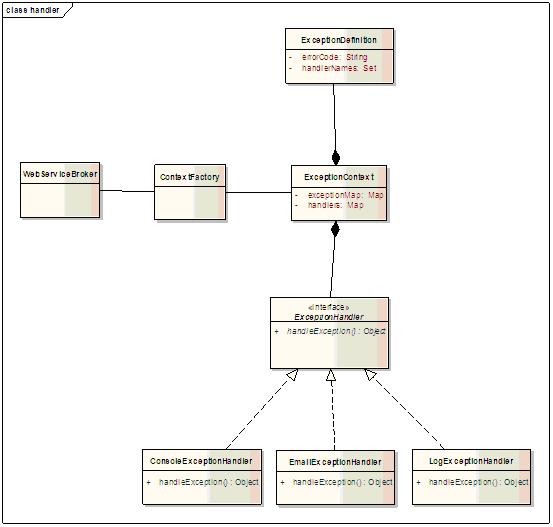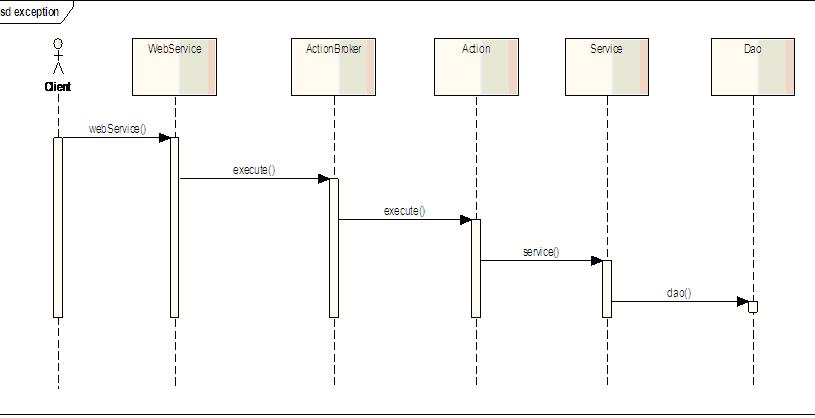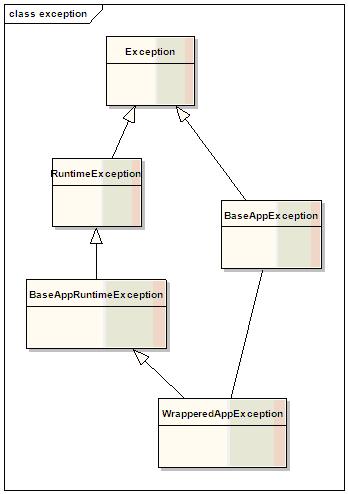應用項目大致的體系結構:
該異常處理框架滿足的要求:
- 完整的異常組織結構
- 異常的統一處理
- 可配置,受管式,方便使用
完整的異常組織結構:
- 用戶可以方便的定義自己的異常,但所有UncheckedException需要繼承BaseAppRuntimeException,所有的checked Exception可以繼承BaseAppException,或者需要拋出且不需要check時用WrapperredAppException封裝后拋出
- 合理地使用checked異常
- Exception有唯一的error code,這樣用戶報告異常后,可以根據異常號找到相應Exception,把exception直接顯示給用戶也沒有太大的意義,如何紀錄exception那就是下文講到的ExceptionHandler的職責了。
- 如果是第三方包括jdk中的異常,需要封裝成BaseAppException或者BaseAppRuntimeException后拋出
統一的異常處理
異常統一在框架中進行處理,不需要在上層應用的代碼中去處理拋出的異常。為了盡量捕捉到所有的異常,將異常處理放在了ActionBroker中,這樣凡是action以后拋出的異常都可以捕捉到,因為webservice只是簡單的調用action類的方法,一般不會出現異常。當我們捕捉到異常后,需要進行異常處理,定義了ExceptionHandler接口,用接口抽象出異常處理類的具體實現。

USFContextFactory: 創建ExceptionContext的工廠
 package com.ldd600.exception.context;
package com.ldd600.exception.context;2

3
 public class CoreContextFactory {
public class CoreContextFactory {4
 private static CoreContextFactory instance;
private static CoreContextFactory instance;5

6
 private volatile ExceptionContext exceptionContext;
private volatile ExceptionContext exceptionContext;7

8
 private Object exceptionContextLock = new Object();
private Object exceptionContextLock = new Object();9

10
 private CoreContextFactory() {
private CoreContextFactory() {11

12
 }
}13

14
 public static synchronized CoreContextFactory getInstance() {
public static synchronized CoreContextFactory getInstance() {15
 if (null == instance) {
if (null == instance) {16
 instance = new CoreContextFactory();
instance = new CoreContextFactory();17
 }
}18
 return instance;
return instance;19
 }
}20

21
 public ExceptionContext getExceptionContext() {
public ExceptionContext getExceptionContext() {22
 ExceptionContext tempExpContext = exceptionContext;
ExceptionContext tempExpContext = exceptionContext;23
 if (tempExpContext == null) {
if (tempExpContext == null) { 24
 synchronized (exceptionContextLock) {
synchronized (exceptionContextLock) {25
 tempExpContext = exceptionContext;
tempExpContext = exceptionContext;26
 if (tempExpContext == null)
if (tempExpContext == null)27
 exceptionContext = tempExpContext = new ExceptionContext();
exceptionContext = tempExpContext = new ExceptionContext();28
 }
}29
 }
}30
 return tempExpContext;
return tempExpContext;31
 }
}32
 }
}33

ExceptionContext: 存放全局的exception信息
 package com.ldd600.exception.context;
package com.ldd600.exception.context;2

3
 import java.util.ArrayList;
import java.util.ArrayList;4
 import java.util.Collection;
import java.util.Collection;5
 import java.util.Collections;
import java.util.Collections;6
 import java.util.HashMap;
import java.util.HashMap;7
 import java.util.List;
import java.util.List;8
 import java.util.Map;
import java.util.Map;9
 import java.util.Set;
import java.util.Set;10

11
 import org.springframework.util.Assert;
import org.springframework.util.Assert;12

13
 import com.ldd600.exception.base.BaseAppRuntimeException;
import com.ldd600.exception.base.BaseAppRuntimeException;14
 import com.ldd600.exception.base.ConfigException;
import com.ldd600.exception.base.ConfigException;15
 import com.ldd600.exception.base.handler.ExceptionHandler;
import com.ldd600.exception.base.handler.ExceptionHandler;16
 import com.ldd600.exception.config.ExceptionDefinition;
import com.ldd600.exception.config.ExceptionDefinition;17

18
 public class ExceptionContext {
public class ExceptionContext {19
 private Map<Class<?>, ExceptionDefinition> exceptionMap;
private Map<Class<?>, ExceptionDefinition> exceptionMap;20

21
 private Map<String, ExceptionHandler> handlers = new HashMap<String, ExceptionHandler>();
private Map<String, ExceptionHandler> handlers = new HashMap<String, ExceptionHandler>();22

23
 ExceptionContext() {
ExceptionContext() {24
 exceptionMap = new HashMap<Class<?>, ExceptionDefinition>();
exceptionMap = new HashMap<Class<?>, ExceptionDefinition>();25
 }
}26

27
 public boolean containsException(Class<?> expClazz) {
public boolean containsException(Class<?> expClazz) {28
 return (exceptionMap.containsKey(expClazz));
return (exceptionMap.containsKey(expClazz));29
 }
}30

31
 public void addExceptionHander(Class<?> expClazz, Class<? extends ExceptionHandler> handlerClazz) {
public void addExceptionHander(Class<?> expClazz, Class<? extends ExceptionHandler> handlerClazz) {32
 try {
try {33
 ExceptionDefinition definition = getRealExceptionDefinition(expClazz);
ExceptionDefinition definition = getRealExceptionDefinition(expClazz);34
 if (null == definition) {
if (null == definition) {35
 throw new IllegalArgumentException(expClazz.getName() + "not in the context, please configure or add it to the context first!!");
throw new IllegalArgumentException(expClazz.getName() + "not in the context, please configure or add it to the context first!!");36
 }
} 37
 ExceptionHandler handler = handlers.get(handlerClazz.getName());
ExceptionHandler handler = handlers.get(handlerClazz.getName());38
 if (null == handler) {
if (null == handler) {39
 handler = handlerClazz.newInstance();
handler = handlerClazz.newInstance();40
 handlers.put(handlerClazz.getName(), handler);
handlers.put(handlerClazz.getName(), handler);41
 }
}42

43
 definition.getHandlerNames().add(handlerClazz.getName());
definition.getHandlerNames().add(handlerClazz.getName());44
 } catch (Exception ex) {
} catch (Exception ex) {45
 throw new ConfigException("Add exception handler to context failure!", ex);
throw new ConfigException("Add exception handler to context failure!", ex);46
 }
}47
 }
}48

49
 public void addExceptionHandler(Class<?> expClazz, String errorCode, Class<? extends ExceptionHandler> handlerClazz) {
public void addExceptionHandler(Class<?> expClazz, String errorCode, Class<? extends ExceptionHandler> handlerClazz) {50
 Assert.hasLength(errorCode, expClazz + " errorCode must not be null or empty string!");
Assert.hasLength(errorCode, expClazz + " errorCode must not be null or empty string!");51
 ExceptionDefinition definition = getRealExceptionDefinition(expClazz);
ExceptionDefinition definition = getRealExceptionDefinition(expClazz);52
 if(null == definition) {
if(null == definition) {53
 definition = new ExceptionDefinition(errorCode);
definition = new ExceptionDefinition(errorCode);54
 exceptionMap.put(expClazz, definition);
exceptionMap.put(expClazz, definition);55
 }
}56
 addExceptionHander(expClazz, handlerClazz);
addExceptionHander(expClazz, handlerClazz);57
 }
}58

59

60

61
 public void addExceptionHandlers(Class<?> expClazz, Class<? extends ExceptionHandler>
public void addExceptionHandlers(Class<?> expClazz, Class<? extends ExceptionHandler> handlerClazzes) {
handlerClazzes) {62
 for(Class<? extends ExceptionHandler> handlerClazz : handlerClazzes) {
for(Class<? extends ExceptionHandler> handlerClazz : handlerClazzes) {63
 addExceptionHander(expClazz, handlerClazz);
addExceptionHander(expClazz, handlerClazz);64
 }
}65
 }
}66

67
 public void removeExceptionHandler(Class<?> expClazz, Class<? extends ExceptionHandler> handlerClazz) {
public void removeExceptionHandler(Class<?> expClazz, Class<? extends ExceptionHandler> handlerClazz) {68
 Assert.isTrue(containsException(expClazz));
Assert.isTrue(containsException(expClazz));69
 String handlerName = handlerClazz.getName();
String handlerName = handlerClazz.getName();70
 getExceptionDefinition(expClazz).getHandlerNames().remove(handlerName);
getExceptionDefinition(expClazz).getHandlerNames().remove(handlerName);71
 Collection<ExceptionDefinition> definitons = exceptionMap.values();
Collection<ExceptionDefinition> definitons = exceptionMap.values();72
 boolean isClearHandler = true;
boolean isClearHandler = true;73
 for (ExceptionDefinition expDefinition : definitons) {
for (ExceptionDefinition expDefinition : definitons) {74
 if (expDefinition.getHandlerNames().contains(handlerName)) {
if (expDefinition.getHandlerNames().contains(handlerName)) {75
 isClearHandler = false;
isClearHandler = false;76
 break;
break;77
 }
}78
 }
}79

80
 if (isClearHandler) {
if (isClearHandler) {81
 handlers.remove(handlers.get(handlerName));
handlers.remove(handlers.get(handlerName));82
 }
}83
 }
}84

85
 public void setExceptionDefinition(Class<?> expClazz, ExceptionDefinition definition) {
public void setExceptionDefinition(Class<?> expClazz, ExceptionDefinition definition) {86
 exceptionMap.put(expClazz, definition);
exceptionMap.put(expClazz, definition);87
 }
}88

89
 public ExceptionDefinition getExceptionDefinition(Class<?> expClazz) {
public ExceptionDefinition getExceptionDefinition(Class<?> expClazz) {90
 if (containsException(expClazz)) {
if (containsException(expClazz)) {91
 return exceptionMap.get(expClazz);
return exceptionMap.get(expClazz); 92
 } else if (BaseAppRuntimeException.class.isAssignableFrom(expClazz.getSuperclass())) {
} else if (BaseAppRuntimeException.class.isAssignableFrom(expClazz.getSuperclass())) {93
 return getExceptionDefinition(expClazz.getSuperclass());
return getExceptionDefinition(expClazz.getSuperclass());94
 } else {
} else {95
 return null;
return null;96
 }
}97
 }
}98

99
 public ExceptionDefinition getRealExceptionDefinition(Class<?> expClazz) {
public ExceptionDefinition getRealExceptionDefinition(Class<?> expClazz) {100
 return exceptionMap.get(expClazz);
return exceptionMap.get(expClazz);101
 }
}102

103
 public List<ExceptionHandler> getExceptionHandlers(Class<?> expClazz){
public List<ExceptionHandler> getExceptionHandlers(Class<?> expClazz){104
 ExceptionDefinition definition = getExceptionDefinition(expClazz);
ExceptionDefinition definition = getExceptionDefinition(expClazz);105
 if (null != definition) {
if (null != definition) {106
 Set<String> handlerNames = definition.getHandlerNames();
Set<String> handlerNames = definition.getHandlerNames();107
 List<ExceptionHandler> handlerList = new ArrayList<ExceptionHandler>(handlerNames.size());
List<ExceptionHandler> handlerList = new ArrayList<ExceptionHandler>(handlerNames.size());108
 for (String handlerName : handlerNames) {
for (String handlerName : handlerNames) {109
 ExceptionHandler handler = handlers.get(handlerName);
ExceptionHandler handler = handlers.get(handlerName);110
 handlerList.add(handler);
handlerList.add(handler);111
 }
}112
 List<ExceptionHandler> resultHandlerList = new ArrayList<ExceptionHandler>(handlerList);
List<ExceptionHandler> resultHandlerList = new ArrayList<ExceptionHandler>(handlerList);113
 return resultHandlerList;
return resultHandlerList;114
 } else {
} else {115
 return Collections.<ExceptionHandler> emptyList();
return Collections.<ExceptionHandler> emptyList();116
 }
}117
 }
}118

119
 public String getErrorCode(Class<?> expClazz){
public String getErrorCode(Class<?> expClazz){120
 ExceptionDefinition definition = getExceptionDefinition(expClazz);
ExceptionDefinition definition = getExceptionDefinition(expClazz);121
 if (null != definition) {
if (null != definition) {122
 return definition.getErrorCode();
return definition.getErrorCode();123
 } else {
} else {124
 return "";
return "";125
 }
}126
 }
}127

128

129
 }
}130

ExceptionDefinition: Exception信息單元
 package com.ldd600.exception.config;
package com.ldd600.exception.config;2

3
 import java.util.LinkedHashSet;
import java.util.LinkedHashSet;4
 import java.util.Set;
import java.util.Set;5

6
 public class ExceptionDefinition {
public class ExceptionDefinition {7
 private String errorCode;
private String errorCode;8

9
 private Set<String> handlerNames = new LinkedHashSet<String> ();
private Set<String> handlerNames = new LinkedHashSet<String> ();10

11
 ExceptionDefinition() {
ExceptionDefinition() {12

13
 }
}14

15
 public ExceptionDefinition(String errorCode) {
public ExceptionDefinition(String errorCode) {16
 this.errorCode = errorCode;
this.errorCode = errorCode;17
 }
}18

19
 public String getErrorCode() {
public String getErrorCode() {20
 return errorCode;
return errorCode;21
 }
}22

23
 public void setErrorCode(String errorCode) {
public void setErrorCode(String errorCode) {24
 this.errorCode = errorCode;
this.errorCode = errorCode;25
 }
}26

27
 public Set<String> getHandlerNames() {
public Set<String> getHandlerNames() {28
 return handlerNames;
return handlerNames;29
 }
}30
 }
}31

ExceptionDefiniton定義了和某個exception相關的具體信息,根據exception的class name可以從exceptionContext中的exceptionMap得到指定的exception的相關信息,這些信息是在系統初始化時讀取到exceptionContext中的。并且避免了exception handler的重復初始化。
可配置,受管式,方便使用
采取兩種配置方式,exception的相關信息比如它的errorCode, exceptionHandlers可以配置在外部的xml文件中,也可以用annotation標注。對于exception的處理是有繼承性質的,如果某個exception沒有在exceptionContext中注冊,就使用它的父類的配置信息。如果無任何父類在exceptionContext中注冊,就使用默認機制進行處理。
XML 方案:
因為spring2.0支持自定義schema功能,我們可以方便地采用自己的schema只要實現NamespaceHandler和BeanDefinitionPaser,后面一個比較重要,可以將自定義xml文件中的相關類注冊到spring的上下文中,成為spring bean。
Xml schema:
 <xsd:complexType name="exceptionType">
<xsd:complexType name="exceptionType"> <xsd:sequence>
<xsd:sequence> <xsd:element name="level" default="error" minOccurs="0">
<xsd:element name="level" default="error" minOccurs="0"> <xsd:simpleType>
<xsd:simpleType> <xsd:restriction base="xsd:string">
<xsd:restriction base="xsd:string"> <xsd:enumeration value="error" />
<xsd:enumeration value="error" /> <xsd:enumeration value="warning" />
<xsd:enumeration value="warning" /> <xsd:enumeration value="info" />
<xsd:enumeration value="info" /> <xsd:enumeration value="confirmation" />
<xsd:enumeration value="confirmation" /> </xsd:restriction>
</xsd:restriction> </xsd:simpleType>
</xsd:simpleType> </xsd:element>
</xsd:element> <xsd:element name="handler" maxOccurs="unbounded">
<xsd:element name="handler" maxOccurs="unbounded"> <xsd:simpleType>
<xsd:simpleType> <xsd:restriction base="xsd:string" />
<xsd:restriction base="xsd:string" /> </xsd:simpleType>
</xsd:simpleType> </xsd:element>
</xsd:element> </xsd:sequence>
</xsd:sequence> <xsd:attribute name="errorCode">
<xsd:attribute name="errorCode"> <xsd:simpleType>
<xsd:simpleType> <xsd:restriction base="xsd:string">
<xsd:restriction base="xsd:string"> <xsd:whiteSpace value="preserve" />
<xsd:whiteSpace value="preserve" /> <xsd:pattern value="LDD600-+"d{1,5}.*" />
<xsd:pattern value="LDD600-+"d{1,5}.*" /> </xsd:restriction>
</xsd:restriction> </xsd:simpleType>
</xsd:simpleType> </xsd:attribute>
</xsd:attribute> <xsd:attribute name="class" type="xsd:string" use="required" />
<xsd:attribute name="class" type="xsd:string" use="required" /> </xsd:complexType>
</xsd:complexType>
Annotation方案:
JDK1.5以上就有了annotation,可以簡化我們的配置,使得配置信息和代碼聯系在一起,增加了代碼的可讀性。如何在spring中注冊自定義的annotation和用annotation標注的class,可以參考文章2和文章: 。對于每個注冊了的class用ExceptionalAnnotationBeanPostProcessor來parse具體的annotation信息(對于annotation的parse方法還會在以后繼續改進)。
 package com.ldd600.exception.annotation;
package com.ldd600.exception.annotation;2

3
 import java.lang.annotation.Documented;
import java.lang.annotation.Documented;4
 import java.lang.annotation.ElementType;
import java.lang.annotation.ElementType;5
 import java.lang.annotation.Retention;
import java.lang.annotation.Retention;6
 import java.lang.annotation.RetentionPolicy;
import java.lang.annotation.RetentionPolicy;7
 import java.lang.annotation.Target;
import java.lang.annotation.Target;8

9
 import com.ldd600.exception.base.handler.ExceptionHandler;
import com.ldd600.exception.base.handler.ExceptionHandler;10

11
 @Target({ElementType.TYPE})
@Target({ElementType.TYPE})12
 @Retention(RetentionPolicy.RUNTIME)
@Retention(RetentionPolicy.RUNTIME)13
 @Documented
@Documented14
 public @interface Exceptional {
public @interface Exceptional {15
 String errorCode();
String errorCode();16
 Class<? extends ExceptionHandler>[] handlers();
Class<? extends ExceptionHandler>[] handlers();17
 }
}18

 package com.ldd600.exception.processor;
package com.ldd600.exception.processor;2

3
 import org.springframework.beans.BeansException;
import org.springframework.beans.BeansException;4
 import org.springframework.beans.factory.config.BeanPostProcessor;
import org.springframework.beans.factory.config.BeanPostProcessor;5

6
 import com.ldd600.exception.annotation.Exceptional;
import com.ldd600.exception.annotation.Exceptional;7
 import com.ldd600.exception.base.BaseAppException;
import com.ldd600.exception.base.BaseAppException;8
 import com.ldd600.exception.base.BaseAppRuntimeException;
import com.ldd600.exception.base.BaseAppRuntimeException;9
 import com.ldd600.exception.config.ExceptionDefinition;
import com.ldd600.exception.config.ExceptionDefinition;10
 import com.ldd600.exception.context.ExceptionContext;
import com.ldd600.exception.context.ExceptionContext;11
 import com.ldd600.exception.context.CoreContextFactory;
import com.ldd600.exception.context.CoreContextFactory;12

13
 public class ExceptionalAnnotationBeanPostProcessor implements BeanPostProcessor {
public class ExceptionalAnnotationBeanPostProcessor implements BeanPostProcessor {14

15
 public Object postProcessAfterInitialization(Object bean, String beanName) throws BeansException {
public Object postProcessAfterInitialization(Object bean, String beanName) throws BeansException {16
 if(bean instanceof BaseAppRuntimeException || bean instanceof BaseAppException) {
if(bean instanceof BaseAppRuntimeException || bean instanceof BaseAppException) {17
 Exceptional exceptional = bean.getClass().getAnnotation(Exceptional.class);
Exceptional exceptional = bean.getClass().getAnnotation(Exceptional.class);18
 if(null != exceptional) {
if(null != exceptional) {19
 ExceptionContext ctx = CoreContextFactory.getInstance().getExceptionContext();
ExceptionContext ctx = CoreContextFactory.getInstance().getExceptionContext();20
 if(!ctx.containsException(bean.getClass())) {
if(!ctx.containsException(bean.getClass())) {21
 ExceptionDefinition expDefinition = new ExceptionDefinition(exceptional.errorCode());
ExceptionDefinition expDefinition = new ExceptionDefinition(exceptional.errorCode());22
 ctx.setExceptionDefinition(bean.getClass(), expDefinition);
ctx.setExceptionDefinition(bean.getClass(), expDefinition);23
 }
}24
 ctx.addExceptionHandlers(bean.getClass(), exceptional.handlers());
ctx.addExceptionHandlers(bean.getClass(), exceptional.handlers());25
 return null;
return null;26
 }
}27
 }
}28
 return bean;
return bean;29
 }
}30

31
 public Object postProcessBeforeInitialization(Object bean, String beanName) throws BeansException {
public Object postProcessBeforeInitialization(Object bean, String beanName) throws BeansException {32
 return bean;
return bean;33
 }
}34

35
 }
}36

結果測試:
 package com.ldd600.exception.test;
package com.ldd600.exception.test;2

3
 import org.jmock.Expectations;
import org.jmock.Expectations;4
 import org.jmock.Mockery;
import org.jmock.Mockery;5
 import org.springframework.beans.factory.BeanFactory;
import org.springframework.beans.factory.BeanFactory;6

7
 import com.ldd600.exception.action.BusinessAction;
import com.ldd600.exception.action.BusinessAction;8
 import com.ldd600.exception.base.BaseAppException;
import com.ldd600.exception.base.BaseAppException;9
 import com.ldd600.exception.base.BaseAppRuntimeException;
import com.ldd600.exception.base.BaseAppRuntimeException;10
 import com.ldd600.exception.base.ConfigException;
import com.ldd600.exception.base.ConfigException;11
 import com.ldd600.exception.base.handler.ConsoleHandler;
import com.ldd600.exception.base.handler.ConsoleHandler;12
 import com.ldd600.exception.context.CoreContextFactory;
import com.ldd600.exception.context.CoreContextFactory;13
 import com.ldd600.exception.dto.DefaultRequest;
import com.ldd600.exception.dto.DefaultRequest;14
 import com.ldd600.exception.dto.DefaultResponse;
import com.ldd600.exception.dto.DefaultResponse;15
 import com.ldd600.exception.dto.Request;
import com.ldd600.exception.dto.Request;16
 import com.ldd600.exception.dto.Response;
import com.ldd600.exception.dto.Response;17
 import com.ldd600.exception.webservice.ActionBrokerImpl;
import com.ldd600.exception.webservice.ActionBrokerImpl;18

19
 public class ExceptionTest extends DependencyInjectionExceptionTestCase {
public class ExceptionTest extends DependencyInjectionExceptionTestCase {20
 Mockery context = new Mockery();
Mockery context = new Mockery();21
 ActionBrokerImpl broker = new ActionBrokerImpl();
ActionBrokerImpl broker = new ActionBrokerImpl();22
 final Request request = new DefaultRequest();
final Request request = new DefaultRequest();23
 final Response response = new DefaultResponse();
final Response response = new DefaultResponse();24

25
 @Override
@Override26
 protected String[] getConfigLocations() {
protected String[] getConfigLocations() {27
 return new String[] { "applicationContext.xml" };
return new String[] { "applicationContext.xml" };28
 }
}29

30
 public void testExceptionThrow() {
public void testExceptionThrow() {31
 final BusinessAction<Response, Request> action = context
final BusinessAction<Response, Request> action = context32
 .mock(BusinessAction.class);
.mock(BusinessAction.class);33
 final BeanFactory beanFactory = context.mock(BeanFactory.class);
final BeanFactory beanFactory = context.mock(BeanFactory.class);34
 assertThrowing(new Closure() {
assertThrowing(new Closure() {35
 public void run() throws Throwable {
public void run() throws Throwable {36
 context.checking(new Expectations() {
context.checking(new Expectations() {37
 {
{38
 allowing(beanFactory).getBean("action");
allowing(beanFactory).getBean("action");39
 will(returnValue(action));
will(returnValue(action));40
 one(action).execute(request, response);
one(action).execute(request, response);41
 will(throwException(new BaseAppException()));
will(throwException(new BaseAppException()));42
 }
}43
 });
});44
 broker.setExceptionHandler(new ConsoleHandler());
broker.setExceptionHandler(new ConsoleHandler());45
 broker.setBeanFactory(beanFactory);
broker.setBeanFactory(beanFactory);46
 broker.execute("action", request, response);
broker.execute("action", request, response);47
 }
}48

49
 }, BaseAppException.class);
}, BaseAppException.class);50
 }
}51

52
 public void testExceptionalAutoLoad() throws BaseAppException {
public void testExceptionalAutoLoad() throws BaseAppException {53
 final BeanFactory beanFactory = context.mock(BeanFactory.class);
final BeanFactory beanFactory = context.mock(BeanFactory.class);54
 final BusinessAction<Response, Request> action = context
final BusinessAction<Response, Request> action = context55
 .mock(BusinessAction.class);
.mock(BusinessAction.class);56
 context.checking(new Expectations() {
context.checking(new Expectations() {57
 {
{58
 allowing(beanFactory).getBean("action");
allowing(beanFactory).getBean("action");59
 will(returnValue(action));
will(returnValue(action));60
 one(action).execute(request, response);
one(action).execute(request, response);61
 will(throwException(new ConfigException()));
will(throwException(new ConfigException()));62
 }
}63
 });
});64
 broker.setBeanFactory(beanFactory);
broker.setBeanFactory(beanFactory);65
 broker.execute("action", request, response);
broker.execute("action", request, response);66
 assertEquals(CoreContextFactory.getInstance().getExceptionContext()
assertEquals(CoreContextFactory.getInstance().getExceptionContext()67
 .getErrorCode(ConfigException.class), "LDD600-00002");
.getErrorCode(ConfigException.class), "LDD600-00002");68
 context.assertIsSatisfied();
context.assertIsSatisfied();69
 }
}70

71
 public void testRuntimeException() {
public void testRuntimeException() {72
 final BusinessAction<Response, Request> action = context
final BusinessAction<Response, Request> action = context73
 .mock(BusinessAction.class);
.mock(BusinessAction.class);74
 final BeanFactory beanFactory = context.mock(BeanFactory.class);
final BeanFactory beanFactory = context.mock(BeanFactory.class);75
 assertThrowing(new Closure() {
assertThrowing(new Closure() {76
 public void run() throws Throwable {
public void run() throws Throwable {77
 context.checking(new Expectations() {
context.checking(new Expectations() {78
 {
{79
 allowing(beanFactory).getBean("action");
allowing(beanFactory).getBean("action");80
 will(returnValue(action));
will(returnValue(action));81
 one(action).execute(request, response);
one(action).execute(request, response);82
 will(throwException(new BaseAppRuntimeException()));
will(throwException(new BaseAppRuntimeException()));83
 }
}84
 });
});85
 broker.setExceptionHandler(new ConsoleHandler());
broker.setExceptionHandler(new ConsoleHandler());86
 broker.setBeanFactory(beanFactory);
broker.setBeanFactory(beanFactory);87
 broker.execute("action", request, response);
broker.execute("action", request, response);88
 }
}89

90
 }, BaseAppRuntimeException.class);
}, BaseAppRuntimeException.class);91
 // test config
// test config92
 assertEquals(CoreContextFactory.getInstance().getExceptionContext()
assertEquals(CoreContextFactory.getInstance().getExceptionContext()93
 .getErrorCode(BaseAppRuntimeException.class), "LDD600-00001");
.getErrorCode(BaseAppRuntimeException.class), "LDD600-00001");94
 // test handler
// test handler95
 assertFalse(response.isSuccess());
assertFalse(response.isSuccess());96
 assertEquals(response.getErrorCode(), CoreContextFactory.getInstance()
assertEquals(response.getErrorCode(), CoreContextFactory.getInstance()97
 .getExceptionContext().getErrorCode(
.getExceptionContext().getErrorCode(98
 BaseAppRuntimeException.class));
BaseAppRuntimeException.class));99
 context.assertIsSatisfied();
context.assertIsSatisfied();100
 }
}101

102
 public void testCheckedException() {
public void testCheckedException() {103
 final BusinessAction<Response, Request> action = context
final BusinessAction<Response, Request> action = context104
 .mock(BusinessAction.class);
.mock(BusinessAction.class);105
 final BeanFactory beanFactory = context.mock(BeanFactory.class);
final BeanFactory beanFactory = context.mock(BeanFactory.class);106
 assertThrowing(new Closure() {
assertThrowing(new Closure() {107
 public void run() throws Throwable {
public void run() throws Throwable {108
 context.checking(new Expectations() {
context.checking(new Expectations() {109
 {
{110
 allowing(beanFactory).getBean("action");
allowing(beanFactory).getBean("action");111
 will(returnValue(action));
will(returnValue(action));112
 one(action).execute(request, response);
one(action).execute(request, response);113
 will(throwException(new ExceptionFaker()));
will(throwException(new ExceptionFaker()));114
 }
}115
 });
});116
 broker.setBeanFactory(beanFactory);
broker.setBeanFactory(beanFactory);117
 broker.execute("action", request, response);
broker.execute("action", request, response);118
 }
}119

120
 }, ExceptionFaker.class);
}, ExceptionFaker.class);121
 // test config
// test config122
 assertEquals(CoreContextFactory.getInstance().getExceptionContext()
assertEquals(CoreContextFactory.getInstance().getExceptionContext()123
 .getErrorCode(ExceptionFaker.class), "LDD600-00003");
.getErrorCode(ExceptionFaker.class), "LDD600-00003");124
 // test handler
// test handler125
 assertFalse(response.isSuccess());
assertFalse(response.isSuccess());126
 assertEquals(response.getErrorCode(), CoreContextFactory.getInstance()
assertEquals(response.getErrorCode(), CoreContextFactory.getInstance()127
 .getExceptionContext().getErrorCode(
.getExceptionContext().getErrorCode(128
 ExceptionFaker.class));
ExceptionFaker.class));129
 context.assertIsSatisfied();
context.assertIsSatisfied();130
 }
}131
 }
}132

參考資料:
文章1:http://www.onjava.com/pub/a/onjava/2006/01/11/exception-handling-framework-for-j2ee.html
文章2:http://sannotations.sourceforge.net/
本文源代碼:源代碼下載









